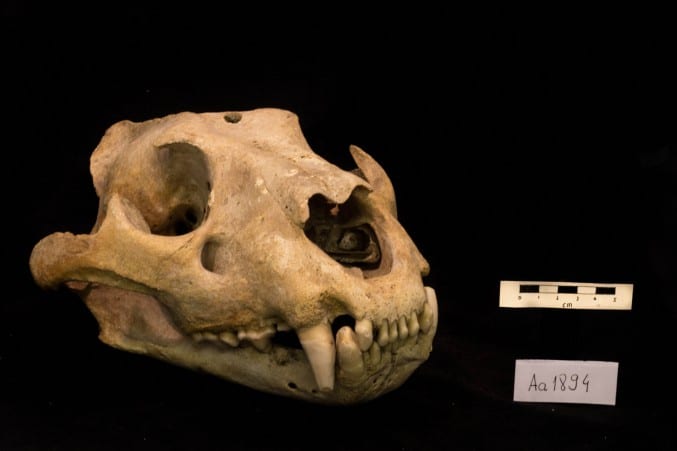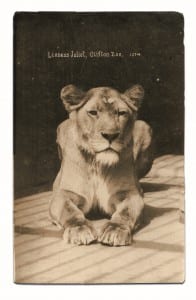The lost lioness returns!
Posted on by Fay Curtis.
Jade Jordan, volunteer with Bonnie Griffin, Curator – Natural History
Whilst rummaging through the natural history stores hidden below Bristol Museum & Art Gallery, we came across a lion skull from the research collection which had an interesting old label, handwritten in copperplate script.
The note stated that the skull (number Aa1894 – see more pictures on our online collection search), belonged to a lioness that had been a gift to Bristol Zoo Gardens from Queen Victoria! We decided to do some investigating to see what more we could find out about this interesting specimen.

Image credit: Heliz Menezes © Bristol Museums, Galleries & Archives
After some digging we discovered our lioness was presented by the Queen in 1895, and had travelled with two other lions, one on its way to London Zoo and the other travelling onward to Dublin Zoo. Bristol Zoo’s head keeper was sent to collect the lioness from London and returned “the same evening with his charge quite safe”.
Bristol Zoo Gardens named her Victoria (of course!) and notes from the time of her arrival state that she was “an exceedingly pretty specimen of Felis leo“. Felis leo is an old Latin name for lion, which today is known as Panthera leo. Victoria the lioness settled well into her new home in Bristol and was said to be “very tame and playful.”
Soon after she came to Bristol, Victoria gave birth to four cubs. The old Zoo records state that Victoria was a very good mother to her cubs: “The lioness shows such motherly solicitude for the youngsters that she is only seen when she comes down to dinner.” In fact she made such a good mother that she had 23 cubs during her lifetime!

© Bristol Zoological Society Ltd
Whilst we were investigating Victoria, we searched through the book ‘An Illustrated History of Bristol Zoo Gardens’ and were delighted to find a picture of one of her cubs, Juliet, born in 1904.
It seems that Victoria the lioness lived a long and happy life at Bristol Zoo Gardens and was 25 when she passed away. Her bones were donated to the museum on 21 February 1918, where they have been looked after ever since. In 2015 a project was started to repackage the skeletons, which led to the discovery of the note and unearthing her story that had been lost for over 100 years.
The project is still underway, who knows what other fascinating stories these skeletons have to tell!
Jade Jordan has been a volunteer with the Natural History team since October 2015.
Thanks to Katie Farquhar at Bristol Zoo Gardens, Dr Andrew Flack whose research was used to add to the story and Letitia Delaleuf and Simon Garrett for permission to use the image of Juliette and Aaron Brett-Miller and Alex Woolcock who are also helping to repackage the bone collection.
- Read more about the history of Bristol Zoo
- Search our collections online
- Find out what our Natural History Team have been up to with the beautiful Broughton Herbarium and our World Wildlife Gallery
- Follow curator Bonnie Griffin on Twitter
One comment on The lost lioness returns!
Lost Lioness Returns 8/1/2016 Skull Aa 1894
For interest (note: No action or reply required) …. Victoria the Lioness is mentioned in Proceeding Zoological Society London 1931. In a paper titled – Contributions to our knowledge of the duration of Life in Vertebrate Animals by Major Stanley S. Flower, OBE, FLS, FZS.
As number 10 of exceptionally aged Lions
“female ‘Victoria’ Clifton Z.G.: Presented when about two years old in March 1895, still living 22.9.1913.” [Note: Bristol Zoo and Clifton Zoological Gardens being one of the same Zoo].
Having Lived on to 1918 it would have made her the longest lived recorded Lion up to that time ((1931) with one, or perhaps two, exceptions (Lion number 15 on list) “male ‘Nero’ Cologne Z.G. died between May 1907 and May 1908. Said to be 29 or nearly 30 years old”. But this record “apparently lacked full documentation” according to Lee S. Crandall (1964) . Further on in text by Flower he continues regarding Dublin Zoo Lions (Lion number 7) “male ‘Pluto’ born 26.6.1889, died 14.7.1914. 25 years, 18 days”.
Either way at age 25 at the time of her death Victoria would have been the longest lived recorded LIONESS at the time of her death. And almost twice as old as the average old age Lion or Lioness.
Major Flower notes “in 1900 the late Dr. H. Bolau, director of the Hamburg Z.G. told me [Flower] to expect a Lion to live four years to a maximum of eighteen years”. Flower arrived at his findings from “One hundred individual Lions and Lionesses selected as those living longest from the available records of twenty-eight public zoological gardens gave an average of thirteen years”.
Major Flower contacts at the Zoological Gardens for Clifton and Bristol were acknowledged as the late Mr. E.W.B.Villiers and Mr. Reginald Woodward.
Graham